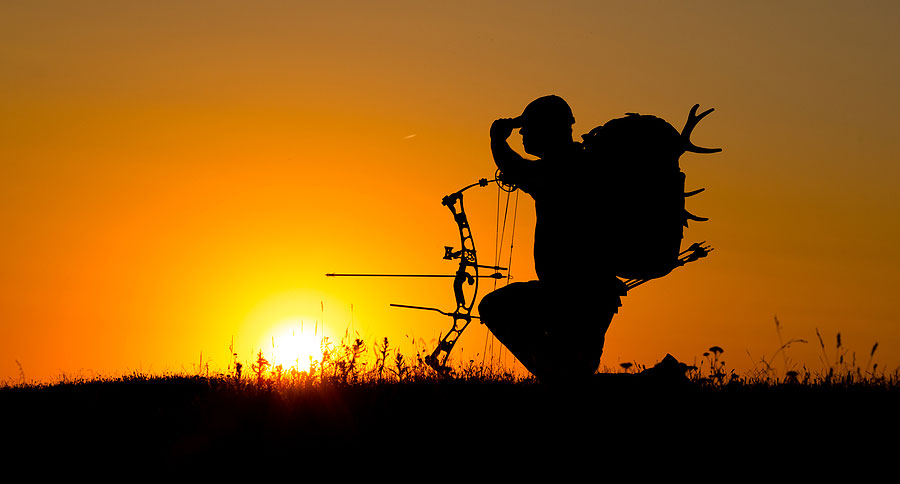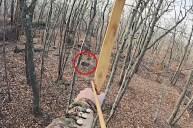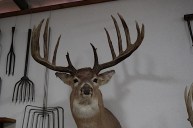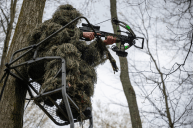The story of the Pope & Young Club is long and full of history figures.
Many bowhunters have a passing familiarity with the Pope and Young Club. This bowhunting organization is the official keepers of world records for North American big game animals harvested via archery equipment. While the record book gets all the attention, many hunters do not realize the club's many contributions to wildlife conservation and the growth of bowhunting for big game as a while.
In fact, it can be argued that without the P&Y Club, modern bowhunting as we know it may not exist at all. This is the story of how a handful of like-minded individuals fostered bowhunting heritage and ushered in a whole new era of modern hunting.
Because the story of the club is also the story of how bowhunting was saved from being a lost hunting tactic.
How bowhunting was nearly lost.
In the mid-1800s, the use a sting and string for harvesting game was already on the way out. It makes logical sense. Firearms were taking over and even the Native Americans who had used bows for thousands of years were making the switch to a weapon that gave a significant distance advantage. After all, there were no conservation organizations then. People did not care about the exact method of harvest. It was just about putting meat on the table and anything that gave an advantage, people took it. In retrospect, we are fortunate that a handful of people kept the tradition alive just long enough for it to become popular again.
As crazy as it sounds, the American Civil War had a part to play in a renewal of interest in bows. More specifically, with brothers Will and Maurice Thompson. These guys served on the Confederate side in the Civil War and once the fighting was over, they returned to their home in Georgia only to find it destroyed. The men were also prohibited from owning firearms by the government. They did fight for the losing side after all.
However, it turned out to be a blessing in disguise because to hunt legally, the brothers took up bows and arrows. They eventually moved to Florida and became quite proficient in shooting birds with a stick and string. Maurice enjoyed bowhunting so much, he wrote a book on the subject in 1878 called "The Witchery of Archery."
This book is cited by Pope and Young as a major factor in renewing a small fringe interest in the challenges of hunting with archery gear. Still, it would take another 33 years and the meeting of four men to really get the modern bowhunting ball rolling and it all started with a Native American man who wandered from isolation in the wilderness.
Ishi, Pope Compton and Young
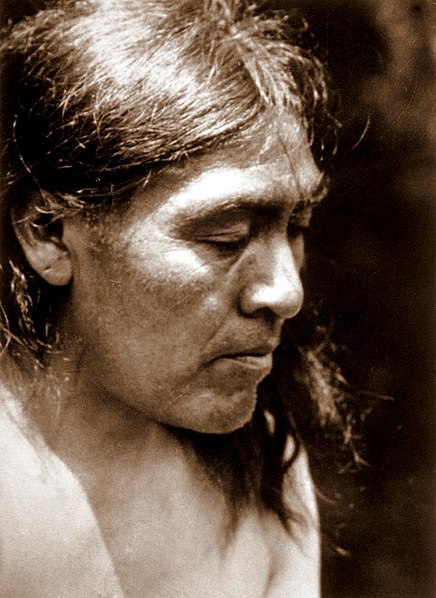
Ishi: Wikimedia Commons: Online Archives of California
Around the same time the Thompson brothers were returning home from the Civil War, the bloody atrocities of the California Indian Wars caused the family of "Ishi," a member of the Yahi Indigenous people, to go into hiding in the wilderness of California. It was there Ishi would stay for the next 44 years. Presumably, this is when he also learned the archery skills that he would later pass on to others.
Around 1908 was when the camp where Ishi lived with his family was discovered and subsequently destroyed. Ishi fled into the wilderness again and attempted to survive off the land. Three years later in 1911, he was captured by authorities and taken to the University of California in Berkeley. Sadly, Ishi's years of isolation meant a lack of immunities to modern disease and the man became sick early and often being in contact with the outside world for the first time. This led to his chance meeting with Texas surgeon Saxton Temple Pope.
Saxton Pope was assigned to be Ishi's physician and the two men became fast friends despite a massive language barrier. Pope did reportedly learn some Yahi language during their time together. It was during this time that Ishi taught Pope how to build the traditional wooden bows and arrows of the Yahi people. Pope took an immense interest in the subject. This led to him writing another influential bowhunting book: "Hunting with the Bow and Arrow."
Approximately 11 years before Ishi walked out of the wilderness, William "Chief" Compton had moved to California and he had brought his love of bowhunting with him. Like the Thompson brothers, Compton was an expert at wingshooting with archery equipment. However, he was also quite talented at harvesting mule deer, elk, moose and more. It was while in California that Compton crossed paths with Arthur Young, a San Francisco reporter and accomplished marksman and rifle hunter.
It was through Compton that Young discovered a brand-new love for bowhunting. Compton eventually introduced Young to Pope and Ishi. With that, four of bowhunting's greatest minds started to show the world just what a bow and arrow could do.
Ishi's passing and Pope & Young's travels
As we already mentioned, Ishi's years of isolation meant lingering health problems. Just five years after leaving the wilderness and entering the modern world, he died of tuberculosis in 1916. Saxton and Pope continued to use what they had learned from Ishi to continue crafting their own hand-made wooden bows. In hindsight, it is wild to think about what the modern state of archery may have been without Ichi's influence on these two men.
Over the next decade, Pope and Young took many hunting trips together and subsequently redefined what one could do with a bow and arrow. The two men hunted grizzlies in Yellowstone National Park, lions and gazelles in Africa and bighorn sheep and bears in Alaska among their other adventures.
The duo also became the first to ever record footage of their adventures. Pope & Young still sells DVDs of their film: "Alaskan Adventures" to this day. While Young did not write a book on the subject, he did write many articles and the news of Pope and Young's adventures traveled far and wide. It ended up inspiring legions of new bowhunters including a young Fred Bear, who abandoned a likely lucrative career in the auto industry to pursue a dream of starting an archery company.
The establishment of bow seasons and the forming of an organization
Pope and Young had lit a spark and the spread of a bowhunting wildfire was inevitable from that point. Fortunately, the tireless efforts of Boone & Crockett Club had already started a huge conservation movement. By the 1930s, hunting laws were well established in most states, although the wording did not contain anything about bowhunting. Wisconsin was the first state to allow the use of a bow as a legal weapon. A few states followed suite after that, but it was still an uphill climb. Mostly because many hunters were skeptical about the effectiveness of the weapon in a time when firearms technology was continually improving.
Another key organization here is the National Archery Association or "NAA." This organization was mostly focused on people shooting archery at targets for fun. In 1939, the National Field Archery Association (NFAA) was formed out of the NAA. The new group had more of a hunting focus and immediately began a large scale push to legitimize bowhunting as an effective way to harvest whitetails and other big game animals.
Slowly, under pressure from the NFAA, more states began to open specific areas and seasons dedicated specifically to bowhunting. This continued for the next 20 years. In the late 1950s, it became apparent to then-NFAA Vice President Glenn St. Charles that archers wanted a record book that recorded trophies like the already-established system used by Boone and Crockett. This idea was also largely seen as a way to better legitimize bowhunting as a serious sport. St. Charles was able to secure permission to use the same scoring system from B&C and in 1958, the idea of the record system was first introduced to the public in Archery Magazine. It was an instant success.
The NFAA compiled records for two years. In 1960, bowhunters gathered for the NFAA awards banquet in Graying, Michigan and decided a splinter organization from NFAA in the style of the highly-successful Boone and Crockett Club was the next logical step for the records program. Measurers quickly began compiling archery big game records from across the nation and the newly formed club absorbed the NFAA's previous two years of records with permission from the organization. Thus, the P&Y records were born.
For the name, the group went with two of the four notable men who started it all, Pope and Young. The new Pope & Young adopted many of B&C's principles on fair chase and a scientific focus on conservation in the process. On January 27, 1961, Pope and Young became an official club. St. Charles was chosen to serve as Chairman and the club's first President. The St. Charles museum of bowhunting was later named in his honor at the club's Chatfield, Minnesota headquarters. That museum has free admission and has continued to promote bowhunting ever since.
The organization's legacy
In the years since Saxton Pope and Arthur Young took their first adventures, all states have officially adopted formal bowhunting seasons. The club's major focus has always been on advocating for bowhunting and they have accomplished their goals on legitimizing the sport. Modern archery and bowhunting are a big business that owe much of their success to the work of this organization. Today, P&Y often works closely alongside Boone & Crockett on the same legislative issues of conservation.
The club also has an extensive youth program designed to attract younger people into the sport of bowhunting. Hunter numbers have been declining for decades and the club faces their biggest challenge in trying to get more hunters into the field pursuing whitetail deer and black bear.
While most hunters may know this club for their records keeping, they do much more than that. Every year, the club's annual convention hosts live auctions that fund not only the organization, but also education programs, state research projects and various conservation projects across the United States.
It is safe to say that the legacy of the club's namesake will be well-remembered and the legacy of bowhunting will continue for some time to come thanks to Pope and Young Club's efforts.
For more outdoor content from Travis Smola, be sure to follow him on Twitter and check out his Geocaching and Outdoors with Travis YouTube channels.
NEXT: THE SIG SAUER CROSS RIFLE FOLDS THE GAP BETWEEN TACTICAL, HUNTING PURPOSES
